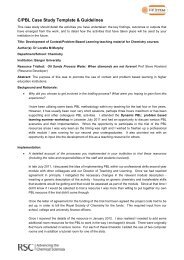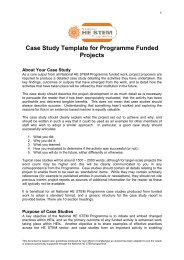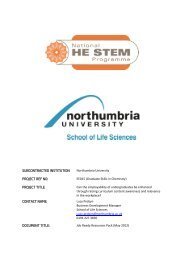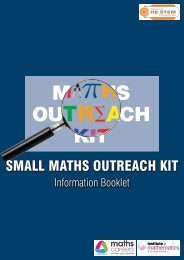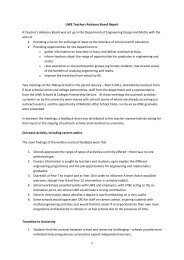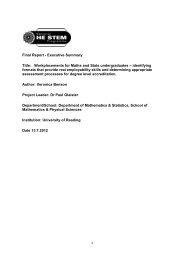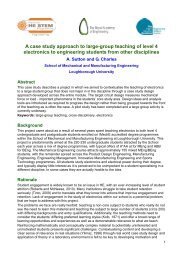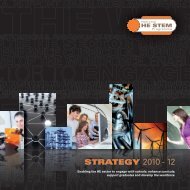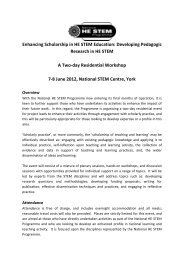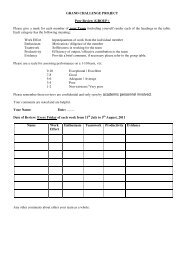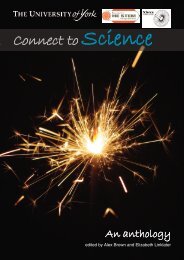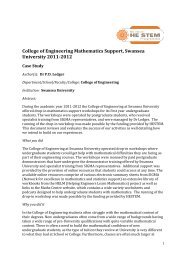Role Models and Case Studies - National HE STEM Programme
Role Models and Case Studies - National HE STEM Programme
Role Models and Case Studies - National HE STEM Programme
You also want an ePaper? Increase the reach of your titles
YUMPU automatically turns print PDFs into web optimized ePapers that Google loves.
'Habitus challengers' (Hodkinson, 1996) can serve as positive role models to challenge fixed<br />
stereotypes over time - such as an uncle being an engineer <strong>and</strong> encouraging his niece - the girl<br />
knows the stereotype of engineering - but can challenge it because of her own knowledge of her<br />
uncle <strong>and</strong> his job. Thus the role model can be very different from the target group - but they need<br />
to be confident enough to challenge stereotypes <strong>and</strong> be supportive when confidence is lacking in<br />
the audience.<br />
Within careers EIAG - signposting young people to case studies / clips can provide additional information<br />
so they make informed choice. So careers advisers need to be able to trust the case studies / role model<br />
examples they are using <strong>and</strong> to know they will not reinforce stereotypes.<br />
At the same time further along the continuum real people role model schemes like <strong>STEM</strong> Ambassadors<br />
are strengthening their delivery <strong>and</strong> diversity to help deliver positive career messages as a part of <strong>STEM</strong><br />
careers education <strong>and</strong> enrichment. This work is just as important…<strong>and</strong> we need to encourage all real life<br />
ambassador programmes as well as those organisations that use them to take the responsibility to be<br />
more aware of how role models are used <strong>and</strong> how they relate to the people they are engaging with.<br />
What works <strong>and</strong> Why<br />
Obviously there are many ways of providing case studies <strong>and</strong> role models - <strong>and</strong> different types can be<br />
made to work in different ways. Examples of use in action include:<br />
<br />
<br />
<br />
<br />
Issues<br />
Women in SET poster exercise - pupils have to guess the job role from a normal photo - then you<br />
explore stereotypes <strong>and</strong> real job roles. This exercise is hugely popular with teachers <strong>and</strong> other<br />
groups - dem<strong>and</strong> is consistent. (www.wiset.org.uk)<br />
Watch short video clips that can be matched across to the curriculum in teaching e.g. In the<br />
Limelight (<strong>STEM</strong> careers) links to Future Morph / science <strong>and</strong> maths / Will the Lighting Designer.<br />
Just a useful context pointer <strong>and</strong> provides a flag for students to explore further.<br />
Direct young people to do their own research about various careers - using www.icould.com or<br />
www.careersbox.co.uk<br />
Real people within schools - for example the Undergraduate Ambassador Scheme (UAS) within<br />
geosciences at Southampton University.<br />
The providers of the case studies vary hugely.<br />
<br />
<br />
<br />
<br />
<br />
Employer case studies are generally there to promote the company as well as the sector. This<br />
can be acknowledged - but sometimes can be too strong <strong>and</strong> sound biased. Careers advisers will<br />
be aware of this.<br />
Sector Skills Councils <strong>and</strong> Professional Societies can provide information one step back from<br />
employer sites - <strong>and</strong> provide useful information linked to the sector or profession / chartered<br />
status - with less bias.<br />
Professional societies with education / career investment provide some really good case studies<br />
within an appealing framework. (Two sites not included in the report – Future Morph is the best<br />
example of this - <strong>and</strong> Maths Careers too).<br />
Careers based providers view <strong>STEM</strong> as one sector amongst many - their focus is wider - which<br />
could be employer wide case studies / information for young people who do not know what they<br />
want / teacher based activities / general careers education.<br />
Those sites with an equality <strong>and</strong> diversity focus are generally looking at one str<strong>and</strong> like gender or<br />
ethnicity - <strong>and</strong> can be useful to break down stereotypes. But there can be a risk in providing an<br />
unreal perspective to some young people.<br />
Different types of media<br />
There are many different media types available including real people, written case studies, posters,<br />
video <strong>and</strong> audio clips <strong>and</strong> films, blogs, online networks. Each has their own strengths <strong>and</strong> weaknesses -<br />
video clips on YouTube can be really accessible for young people if short <strong>and</strong> snappy - but written case<br />
studies <strong>and</strong> posters still go down well with teachers for young people in school. Written case studies<br />
page 2/12




